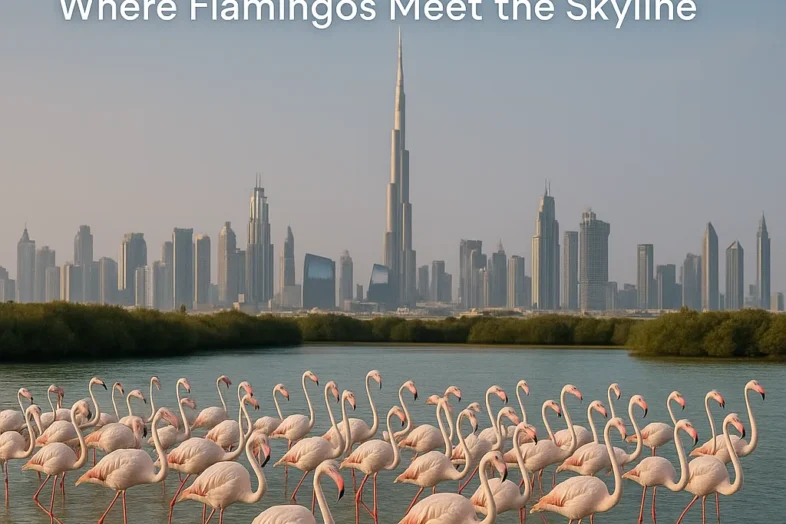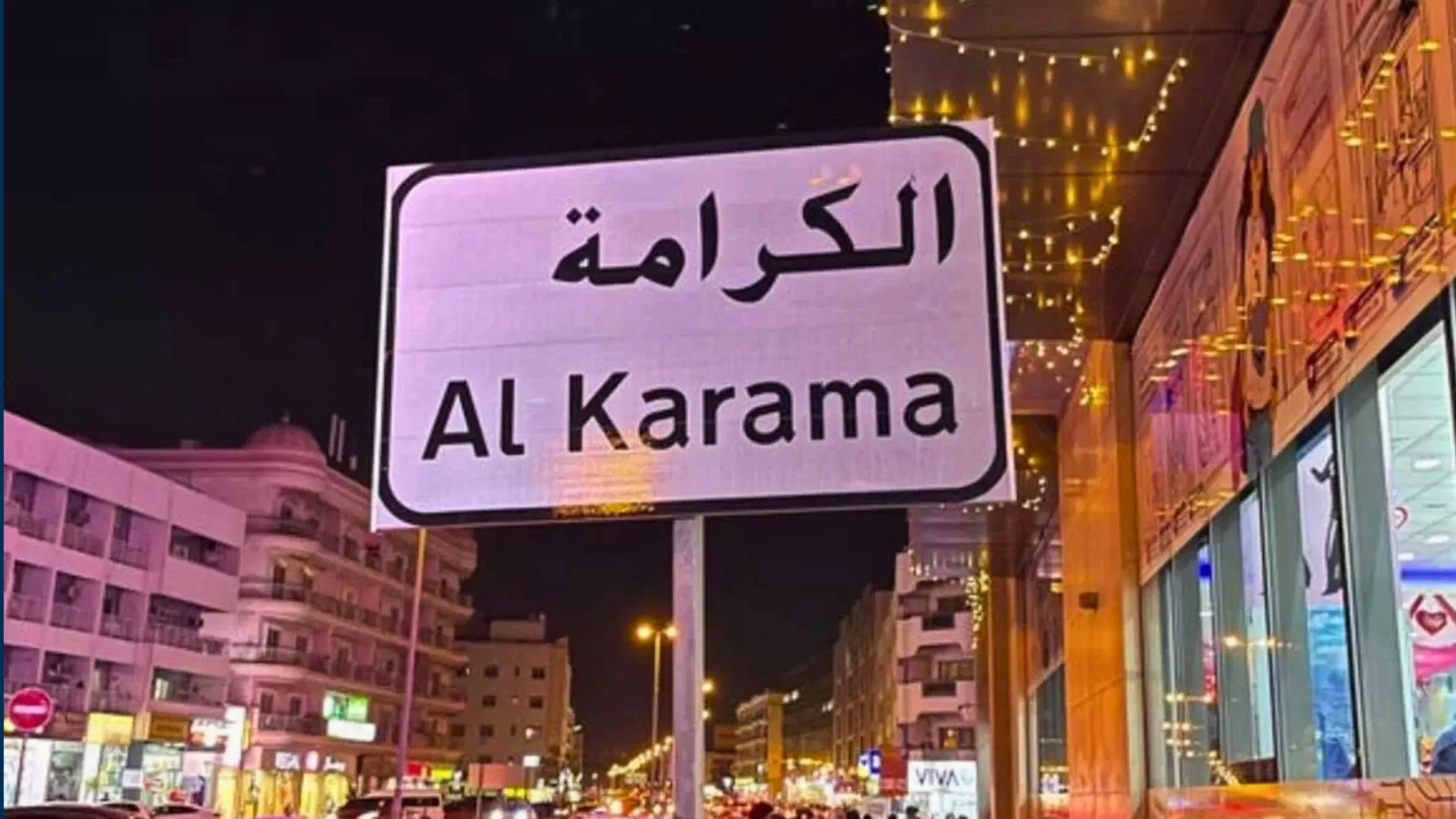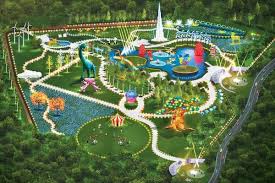
Imagine flamingos wading through Dubai’s wetlands with the Burj Khalifa glimmering behind them. Welcome to Ras Al Khor Dubai – one of the world’s few urban protected wetlands where nature thrives amid a bustling metropolis.
Located at the inland end of Dubai Creek, near the futuristic Dubai Creek Harbour, this 6.2 square kilometre sanctuary is proof that progress and preservation can coexist. The Ras Al Khor Wildlife Sanctuary attracts more than 20,000 waterbirds each year, making it a paradise for birdwatchers, photographers, and families seeking an escape from city chaos.
What makes this place unique? The Ras Al Khor Industrial Area – with its warehouses and logistics hubs (Industrial Area 1, 2, and 3) – operates just meters away from protected wetlands. It’s Dubai’s commitment to sustainability in action: where industry and wildlife share the skyline.
Whether you’re searching for “where can I see flamingos in Dubai” or planning a visit to the Ras Al Khor Flamingo Hide Viewing Area, this guide covers everything you need to plan your visit.
📋 Quick Facts
Location: Dubai Creek, near Dubai Creek Harbour
Entry Fee: Free
Timings: Typically 9:00 AM – 4:00 PM (Saturday–Thursday); often closed Fridays/holidays – confirm before visiting
Best Time to Visit: November to February
Area: 6.2 square kilometres (620 hectares)
Accessibility: Hides have level access and shaded seating; limited shade on paths
The Story Behind Ras Al Khor: From Coastal Wetland to Conservation Icon 📖
What Does “Ras Al Khor” Mean?
Ras Al Khor (رأس الخور) translates to “Cape of the Creek” or “Head of the Creek” in Arabic. The name perfectly captures its geography – a headland where Dubai Creek curves inland, creating nutrient-rich mudflats and salt marshes.
From Fishing Village to Protected Sanctuary
The Ras Al Khor area has evolved dramatically over decades. What began as a traditional fishing and pearling community transformed into a protected ecosystem through careful planning:
- Pre-1970s: Natural wetlands supported local fishing communities
- 1985: Environmental surveys documented rare bird species
- 1998: Officially declared a wildlife sanctuary by Dubai Municipality
- 2007: Became the UAE’s first Ramsar Wetland of International Importance
- 2018+: Integration with Dubai Creek Harbour; enhanced viewing facilities
Conservation Champions 🏆
The Dubai Municipality’s Environment Department manages the sanctuary, balancing urban growth with ecological protection. Their efforts include buffer zones separating industrial areas from sensitive habitats, annual bird counts and migration tracking, educational programs for schools, and collaboration with international conservation bodies.
Unlike many cities where development erases nature, Dubai chose integration. The result? A bird sanctuary where you might spot a Dalmatian Pelican while trucks rumble past Ras Al Khor Terminus 1.
Ras Al Khor Wildlife Sanctuary: A Bird Lover’s Paradise 🦅
Overview: Dubai’s Living Laboratory
The Ras Al Khor Wildlife Sanctuary isn’t just a park – it’s a functioning ecosystem supporting:
- 🦩 Dozens of bird species with many breeding on site
- 🌊 Mudflats, lagoons, and mangroves – rare in arid climates
- 🔬 Ongoing monitoring of wetland health and migration patterns
Key Stats:
- Area: 6.2 square kilometres (620 hectares)
- Annual Visitors (birds): 15,000–20,000 waterbirds
- Peak Season: October–March (winter migration)
The Stars of the Show: Flamingos in Dubai 💗
Greater Flamingos (Phoenicopterus roseus)
The flamingos at Ras Al Khor are the sanctuary’s main attraction. Here’s what makes them special:
Population: 1,000–2,000 individuals (seasonal)
Color Source: Diet of algae and brine shrimp rich in carotenoids
Behavior: Filter-feeding in shallow water; distinctive “marching” courtship displays
Best Viewing Time: Early morning (6–9 AM) or late afternoon (4–6 PM)
Fun Fact: These aren’t permanent residents! They migrate from colder regions, making Ras Al Khor a winter vacation spot for flamingos. 🧳✈️
Beyond Flamingos: The Supporting Cast 🎭
The sanctuary hosts impressive avian diversity:
Resident Species:
- 🦆 Grey Heron – Stealthy hunters in mangroves
- 🕊️ Western Reef Heron – Both white and dark morphs present
- 🦢 Great Egret – Elegant waders with striking yellow bills
Migratory Guests:
- 🌍 Broad-billed Sandpiper (from Siberia)
- 🦜 Eurasian Coot (Central Asian lakes)
- 🐦 Black-winged Stilt (Mediterranean region)
Rare Sightings:
- 🌟 Dalmatian Pelican – Critically endangered globally
- 🦌 Greater Spotted Eagle – Occasional winter visitor
The Ras Al Khor Flamingo Hide Viewing Area 🔭
What to Expect
Three observation hides offer prime viewing without disturbing wildlife:
- Hide A (Mangrove Hide) – Closest to creek, best for herons
- Hide B (Lagoon Hide) – Prime flamingo viewing spot
- Hide C (Flamingo Hide) – Telescope-equipped, ideal for photographers
Facilities:
- ✅ Wooden walkways and shaded platforms
- ✅ Informational panels (English/Arabic)
- ✅ Telescopes and binoculars (bring your own for better quality)
- ✅ Accessible seating
Visitor Rules (Please Follow!):
- 🚫 No feeding birds
- 🚫 No drones (prohibited in the sanctuary)
- 📸 Photography allowed (no flash)
- 🤫 Keep noise minimal
- 🗑️ Carry out all trash
- 🐕 No pets allowed
Ecosystem Importance: Why This Matters 🌍
The wildlife sanctuary plays critical roles:
- Rest Stop for Migrants: A crucial feeding ground for birds on long migrations
- Breeding Ground: Safe nesting sites for regional species
- Water Purification: Wetlands filter pollutants from Dubai Creek
- Climate Regulation: Mangroves sequester carbon and stabilize shorelines
- Educational Resource: Living classroom for thousands of students annually
Best Time to Visit & Visitor Information 🗓️
When to Go: Seasonal Guide
October–March (Peak Season) ⭐
Best birding, pleasant 20–30°C, large flamingo flocks. Moderate crowds.
April–May
Breeding season, fewer migrants but active residents. Low crowds.
June–September
Open, but heat (40°C+) and low bird activity make viewing tougher. Very low crowds.
Best window: November–February – ideal weather plus maximum bird diversity.
Timings & Entry Details
Standard Hours (check Dubai Municipality’s website before visiting):
- 📅 Open: Saturday–Thursday
- ⏰ Hours: Typically 9:00 AM – 4:00 PM
- 🚫 Often Closed: Fridays and public holidays
- 🎟️ Ticket Price: FREE!
Important: Entry is free, but advance registration may be required during peak season. Always verify current timings and closures online.
How to Reach Ras Al Khor Location 🚗🚇
By Metro:
- Nearest existing stations: Creek (Green Line) or Business Bay (Red Line)
- Take a taxi from either station (10–20 minutes to sanctuary)
- Note: A Ras Al Khor station is planned for the future Blue Line
By Car:
- From Downtown Dubai: Take Al Khail Road → Exit toward Ras Al Khor Industrial Area
- Parking: Free parking available near viewing hides
- GPS search: “Ras Al Khor Wildlife Sanctuary” or coordinates 25.1833° N, 55.3333° E (approximate)
By Taxi/Rideshare:
- Tell driver: “Ras Al Khor Wildlife Sanctuary viewing hides”
- Drop-off point near Hide B (main entrance)
Visitor Tips 📝
For Photographers:
- 📷 Bring telephoto lens (300mm+ recommended)
- 🌅 Golden hour (6–7 AM or 5–6 PM) offers best light
- 🦩 Use tripod for stability; carry a small beanbag if tripods aren’t allowed in crowded hides
For Families:
- 👶 Stroller-friendly pathways
- 🧃 Bring water and snacks (no on-site vendors)
- 🎒 Sunscreen and hats essential (limited shade)
For Serious Birders:
- 🔭 Bring field guides or use Merlin Bird ID app
- 📊 Log sightings on eBird to contribute data
- 🤝 Join Dubai Natural History Group for guided walks
Ras Al Khor Industrial Area: Where Commerce Meets Conservation 🏭🌿
The Coexistence Model
Many visitors wonder: How does an industrial area border a wildlife sanctuary? The answer lies in smart urban planning.
The Ras Al Khor Industrial Area (منطقة رأس الخور الصناعية دبي) consists of three main zones. Ras Al Khor Industrial Area 1 handles warehousing and logistics (500m+ from the sanctuary). Ras Al Khor Industrial Area 2 focuses on light manufacturing and carpentry (700m+ away). Ras Al Khor Industrial Area 3 contains auto services and showrooms (1km+ distance).
Smart Sustainability Measures:
Dubai has implemented several key protections to ensure industry and nature coexist:
- 🚰 Wastewater treatment prevents creek pollution
- 🌳 Green buffer zones separate industrial areas from wetlands
- 📉 Noise barriers protect nesting sites
- ♻️ Recycling mandates for all businesses
Economic & Ecological Balance ⚖️
The Ras Al Khor area demonstrates Dubai’s dual vision. Economically, it employs over 10,000 workers, serves as a strategic logistics hub near ports and airports, and supports the construction boom as a materials center. Ecologically, creek water is monitored for industrial discharge, and native plants are restored along industrial borders to create wildlife corridors.
Nearby Attractions: Extend Your Eco-Adventure 🗺️
1. Al Khor Park (Sharjah) 🎡
Located approximately 25 km away in Sharjah, Al Khor Park offers family fun:
Features:
- 🦁 Mini zoo with Arabian Oryx, gazelles, and monkeys
- 🚣 Paddle boats on artificial lake
- 🎠 Children’s play areas and cable car
- 🌳 Landscaped gardens with picnic spots
Al Khor Park Ticket Price: Around AED 5 per person (check current rates)
Note: This is different from Ras Al Khor Wildlife Sanctuary – it’s a separate park in Sharjah.
2. Dubai Creek Harbour Viewing Areas 🏙️
The futuristic Dubai Creek Harbour development includes public promenades where you can:
- 🦩 Spot flamingos from an urban setting
- 🍽️ Dine at waterfront restaurants in the Marsa Al Khor area
- 🚶 Walk the Creek Beach boardwalk
Unique Experience: Watch flamingo flocks against the backdrop of Dubai’s skyline – Instagram gold! 📸
3. Al Khor Plaza & Local Shopping 🛍️
For a break from nature:
- Al Khor Plaza – Local shopping center with groceries, cafes
- Dafan Al Khor – Traditional market nearby
4. Day-Trip Itinerary 📅
Morning:
- 6:00 AM: Sunrise at Ras Al Khor Flamingo Hide
- 9:00 AM: Breakfast at Dubai Creek Harbour cafe
Afternoon:
- 11:00 AM: Explore Creek Harbour promenade
- 1:00 PM: Lunch at Marsa Al Khor waterfront
Evening:
- 4:00 PM: Return to sanctuary for golden hour photography
- 6:00 PM: Dinner with creek views
Wildlife Beyond Ras Al Khor: Exploring UAE’s Sanctuaries 🇦🇪
Comparing UAE’s Protected Areas
Ras Al Khor Wildlife Sanctuary (Dubai): Urban wetlands specializing in flamingos, located right in the city.
Al Wathba Wetland Reserve (Abu Dhabi): Largest flamingo colony with 4,000+ birds, 135 km from Dubai.
Wasit Wetland Centre (Sharjah): Desert/wetland mix, migration hub, just 25 km from Dubai.
Jebel Ali Wildlife Sanctuary (Dubai): Coastal sabkha habitat, migratory waders, 40 km away.
Wadi Al Safa Wildlife Centre (Dubai): Rehabilitation center, 30 km distance (not open for public viewing).
UAE National Animal and Bird 🏆
- 🐪 National Animal: Arabian Oryx (Oryx leucoryx)
- 🦅 National Bird: Falcon (Falco species)
Note: The falcon holds cultural significance in Emirati heritage, featured on currency and government emblems.
Conservation Challenges in the Desert 🌵
UAE sanctuaries face unique obstacles including water scarcity (wetlands depend on treated wastewater), urban pressure from development, climate change altering migration patterns, and ongoing environmental remediation efforts.
Success Stories:
- Arabian Oryx brought back from near-extinction through breeding programs
- Mangrove forests significantly expanded since 2010 via replanting initiatives
Photography & Eco-Tourism Opportunities 📷🌿
Best Spots for Bird Photography
1. Hide B (Lagoon Hide) ⭐⭐⭐⭐⭐
- Best For: Wide-angle flamingo flocks
- Light: Morning front-lit, afternoon side-lit
- Challenge: Distance (~50m to birds)
2. Hide C (Flamingo Hide) ⭐⭐⭐⭐
- Best For: Close-up portraits with telephoto
- Light: Afternoon optimal
- Challenge: Crowded on weekends
3. Creek Harbour Promenade ⭐⭐⭐
- Best For: Skyline + flamingo compositions
- Light: Sunset magic hour
- Challenge: Public area with pedestrian traffic
Gear Recommendations 🎒
Essential:
- 📸 Camera with 400mm+ lens (full-frame equivalent)
- 🦵 Sturdy tripod or monopod
- 💼 Small beanbag (useful if tripods restricted in crowded hides)
- 🧢 Camouflage or neutral-colored clothing (greens/browns) to blend in
Optional:
- 🔭 Spotting scope for distant identification
- 📱 Smartphone + adapter for digiscoping
- 🎧 Parabolic microphone for bird calls
Guided Tours: Flamingo Dubai Tour Options 🗺️
While the sanctuary is self-guided, several operators offer:
- 🚐 Eco-tourism packages combining Ras Al Khor with desert conservation areas
- 🌅 Photography workshops led by wildlife professionals
- 🎓 School field trips with educational components
Book Through:
- Dubai Tourism official partners
- Local photography clubs (check Dubai Natural History Group)
- Bird watching groups offering occasional trips
Ethical Wildlife Tourism 🙏
Do:
- ✅ Keep 50m+ distance from birds
- ✅ Use silent shutter mode
- ✅ Report injured wildlife to Ras Al Khor Police Station (+971 4 285 1111)
Don’t:
- ❌ Use drones (illegal in sanctuary)
- ❌ Play bird calls to lure subjects
- ❌ Leave paths to get closer
Local Culture & Community Involvement 🤝
Education Programs 🎓
Dubai Municipality runs school visits with 150+ schools participating annually, university research partnerships with UAE University and Zayed University, plus corporate CSR events where companies sponsor cleanups and awareness days.
Fun Fact: The sanctuary’s حديقة الطيور (Arabic for “bird park”) nickname is popular among Emirati families teaching kids about conservation.
Community Initiatives 🌟
Annual Events:
- 🦩 World Migratory Bird Day (May) – free guided walks
- 🌊 Creek Cleanup Drives (quarterly) – volunteers remove plastic
- 📸 Photography Competitions – prizes for best sanctuary shots
Volunteer Opportunities:
- Sign up via Dubai Municipality website
- Activities include trail maintenance, bird counts, visitor education
Cultural Significance 🕌
For many Emiratis, Ras Al Khor represents a heritage connection as a reminder of pre-development Dubai, a spiritual retreat offering peaceful escape in a hectic city, and environmental pride showcasing UAE’s commitment to sustainability.
Quote from Local Conservationist:
“My grandfather fished these waters. Now my grandchildren watch flamingos here. Ras Al Khor is our past and future.” – Ahmed Al Mansouri, Dubai resident
FAQs: Everything Else You Need to Know ❓
Where is Ras Al Khor exactly?
Located at the inland end of Dubai Creek, near Ras Al Khor Road and Al Khawaneej. The planned Ras Al Khor Terminus 1 metro station will serve as a future landmark.
Can I see flamingos year-round?
Yes, but numbers vary. October–March has 1,000–2,000 flamingos; summer months may have 100–300.
Are there flamingos near me (if I’m in Dubai)?
Ras Al Khor Wildlife Sanctuary is the primary and most reliable spot for flamingo sightings in Dubai. This is your best bet for guaranteed viewing.
What’s the difference between Ras Al Khor and Ras Al Khaimah?
Common confusion! Ras Al Khor = Dubai wetlands and bird sanctuary. Ras Al Khaimah (RAK) = Northern emirate with RAK Zoo and mountains. Totally different places! 😄
Is there a “Black Flamingo Dubai”?
No verified sightings of melanistic (black) flamingos at Ras Al Khor. This myth likely stems from dark-plumaged Western Reef Herons.
Where else can I see wildlife in Dubai?
- Dubai Safari Park – Land animals (giraffes, lions)
- The Green Planet – Indoor rainforest biodome
- Dubai Aquarium – Marine life
- Jebel Ali Wildlife Sanctuary – Coastal birds
Conclusion: A Testament to Harmony 🌏💚
Amid skyscrapers and highways, Ras Al Khor Wildlife Sanctuary stands as Dubai’s quiet reminder that innovation and nature can thrive side by side.
Every winter, when thousands of flamingos return to these shores, they vote with their wings: this place is safe, welcoming, and worth protecting. The sight of their pink formations against glass towers is a powerful statement about what’s possible when cities prioritize both progress and preservation.
Whether you’re a photographer chasing the perfect shot, a parent seeking educational adventures, or simply someone craving quiet amid urban chaos, this sanctuary offers renewal in every sense.
Plan your visit. Respect the rules. And let this hidden oasis renew your faith in coexistence. 🦩✨
Quick Checklist Before You Go ✅
- [ ] Check current Ras Al Khor Wildlife Sanctuary timings on Dubai Municipality website (often closed Fridays!)
- [ ] Bring binoculars or camera with telephoto lens
- [ ] Wear comfortable walking shoes + sun protection
- [ ] Download offline map or save directions
- [ ] Register for guided tours (if available)
- [ ] Respect wildlife – no feeding, no flash, no drones
- [ ] Consider combining with Dubai Creek Harbour visit for a full day
For more info: Dubai Municipality Environment Department
📞 +971 4 206 4222
🌐 dm.gov.ae
Have you visited the bird sanctuary? Share your flamingo photos and experiences! 📸💬







Add Comment
You must be logged in to post a comment.